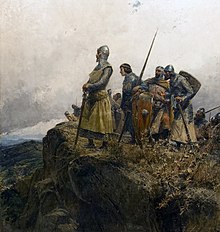Confiscation of Mallorca
The confiscation of Mallorca occurred in 1285 during the Crusade against Aragon (1283-1286). It was about the violent annexation of the Kingdom of Mallorca by the King of Catalonia and Aragon Alfons III.
course
Pope Martin IV. , The successor of Clement IV. , Had on March 21, 1283 the king of Aragon Peter III. exempted from church and enfeoffed Charles I of Anjou with the Kingdom of Sicily .
French invasion
Advance
The French then occupied the Vall d'Aran in 1283 , but were unable to advance further into Catalan territory . The following year they tried again by means of troop units stationed in the Kingdom of Navarre . Tudela was besieged in the Catalan-Aragonese counterattack in 1284 . In 1285 the French invaded the county of Roussillon , which belonged to the realm of James II of Mallorca, with a huge army of 100,000 foot soldiers, 16,000 knights and 17,000 crossbowmen . The French King Philip III. Commanded army initially camped at Elne and Perpignan and then crossed the Coll de la Maçana in June . The Catalans used the scorched earth tactic on their gradual retreat , but the French continued to advance, gradually capturing Castelló d'Empúries , Girona , Figueres , Roses , Sant Feliu de Guíxols and Blanes . Peralada was burned down but did not surrender.
retreat
The Catalan squadron commanded by Ruggiero di Lauria had broken up the French fleet on their way back from Sicily in the naval battle of Formigues and landed in northern Catalonia. At about the same time, the dysentery broke out in the French army . Surrounded, without supplies and infested with disease, it had to retreat north again, but in the meantime the two pass crossings ( Pertus and Maçana) had been cut off. In this situation the Catalan detachments still held back from attacking, preferring instead to let the French evade to Agullana . However, part of the French army tried to cross the Col de Pertus via La Jonquera .
After the French had evaded, the Catalan army advanced and now awaited the enemy at La Jonquera. There the Catalans attacked the rearguard of the French weakened by the disease and inflicted heavy losses on them. So Ramon III. de Montcada, with his vanguard consisting of Almogàvers , massacred all fleeing people and thus terrified the French king and his family, including the future heir to the throne Charles I from the House of Valois (Karl's mother Isabella was a sister of Peter III. and thus Charles also had claims to the Crown of Aragon ). After this attack, the French army was attacked again by Ruggiero di Lauria's troops, who had landed at Empordà after his naval victory. The French lost all cities around Girona and Empordà, but were still able to hold Roussillon.
Attack on Mallorca
In 1285, as revenge for his brother Jacob II's participation in the crusade on the part of France, Peter III sent a naval force from Salou to Mallorca with the intention of confiscating his kingdom of Mallorca from him. Peter III but could no longer enjoy the end result of this undertaking, as he had died shortly before in Vilafranca del Penedès .
On November 19th of the same year, Palma de Mallorca Alfons III. , the successor of Peter III., devoted without a fight. A few days later, on November 24th, Ponç Saguàrdia , the governor of Jacob II, presented Alfons III. the keys of the city and the representatives of the city people swore their oath of loyalty to him.
On November 25, 1285 Alfons III passed. on the surrender of Ramon Ballester , who commanded the Castell d'Alaró . Since this did not obey, the order to storm the fortress and its garrison was given on November 30th . Ramon Ballester, Guillem Capello known as "Cabrit", Guillem Bassa , Arnau Ramon, Lleonard Marsello and Albert Perpinyà were killed in a spreading conflagration.
Aftermath
With the exception of the Balearic Islands, James II was able to preserve all of his other territories. However, in 1295 he succeeded in regaining the islands in the Peace of Anagni on the same terms as those laid down in the Treaty of Perpignan of 1279.
Individual evidence
- ↑ Figueres, Josep M: Història contemporània de Catalunya . Editorial UOC, 2003, ISBN 84-8318-773-6 , p. 34 .

